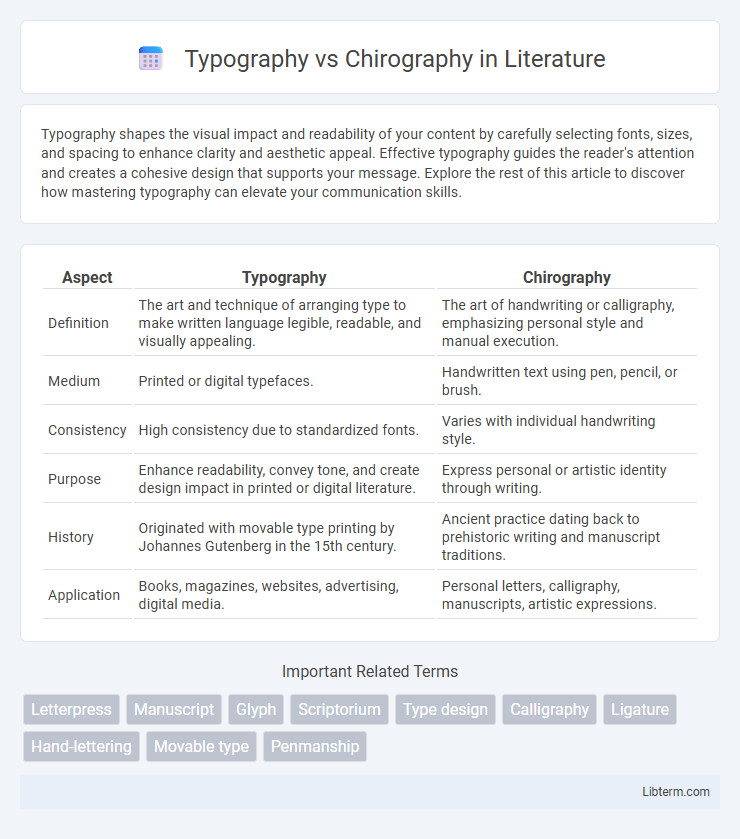Typography shapes the visual impact and readability of your content by carefully selecting fonts, sizes, and spacing to enhance clarity and aesthetic appeal. Effective typography guides the reader's attention and creates a cohesive design that supports your message. Explore the rest of this article to discover how mastering typography can elevate your communication skills.
Table of Comparison
| Aspect | Typography | Chirography |
|---|---|---|
| Definition | The art and technique of arranging type to make written language legible, readable, and visually appealing. | The art of handwriting or calligraphy, emphasizing personal style and manual execution. |
| Medium | Printed or digital typefaces. | Handwritten text using pen, pencil, or brush. |
| Consistency | High consistency due to standardized fonts. | Varies with individual handwriting style. |
| Purpose | Enhance readability, convey tone, and create design impact in printed or digital literature. | Express personal or artistic identity through writing. |
| History | Originated with movable type printing by Johannes Gutenberg in the 15th century. | Ancient practice dating back to prehistoric writing and manuscript traditions. |
| Application | Books, magazines, websites, advertising, digital media. | Personal letters, calligraphy, manuscripts, artistic expressions. |
Understanding Typography: Definition and Scope
Typography involves the art and technique of arranging type to make written language legible, readable, and visually appealing, encompassing font selection, size, spacing, and layout. It is a crucial element in graphic design, digital interfaces, and print media, influencing how information is perceived and interpreted. Unlike chirography, which centers on the personal and expressive aspects of handwriting, typography prioritizes standardization and clarity through reproducible typefaces.
What is Chirography? Key Concepts Explained
Chirography is the art and study of handwriting, emphasizing the unique, personal expression found in an individual's penmanship. It involves analyzing letterforms, strokes, and patterns that reveal character and motor skills, distinguishing it from typography's mechanically produced typefaces. Understanding chirography enhances forensic analysis, artistic calligraphy, and educational methods focused on handwriting development and legibility.
Historical Evolution: Typography vs Chirography
Typography evolved from movable type invented by Johannes Gutenberg in the 15th century, revolutionizing mass printing and standardizing letterforms across texts. Chirography, or handwriting, dates back to ancient civilizations with unique scripts like cuneiform and hieroglyphs, emphasizing personal expression and cultural identity. Historically, typography enabled rapid dissemination of information, while chirography preserved individual creativity and document authenticity throughout centuries.
Major Differences Between Typography and Chirography
Typography involves designing and arranging typefaces in print or digital media, emphasizing font selection, spacing, and readability for mass communication. Chirography, or handwriting, centers on the manual creation of letters with unique personal style, often reflecting individual expression and fine motor skills. Major differences include typography's reliance on reproducible digital or mechanical processes, whereas chirography is inherently manual and variable.
The Role of Technology in Typography and Chirography
Technology has revolutionized typography by enabling precise digital font design, widespread font distribution, and versatile text manipulation across various digital platforms. In contrast, technology's role in chirography primarily enhances the study and preservation of handwritten texts through digital imaging and analysis tools rather than altering the fundamental art of handwriting. Advances such as computer-aided design software and digital ink devices blur traditional boundaries, fostering new creative possibilities between typed and handwritten forms.
Artistic Expression: Handwriting vs Typesetting
Typography emphasizes precision and consistency through typesetting, allowing designers to manipulate fonts, spacing, and layout for visually impactful communication. Chirography, or handwriting, showcases unique artistic expression with personal flair, stroke variation, and organic imperfections that convey emotional depth. The contrast lies in typography's mechanical uniformity versus chirography's individualized, dynamic character.
Practical Applications: Where Typography and Chirography Shine
Typography excels in digital design, branding, and mass communication by providing consistent, scalable, and easily readable text across various media platforms. Chirography thrives in personal expression, calligraphy art, and historical document preservation, where unique handwriting styles convey individuality and cultural heritage. Both disciplines serve complementary practical roles: typography ensures clarity and efficiency in information dissemination, while chirography enhances emotional impact and aesthetic value through handcrafted detail.
Legibility and Readability: A Comparative Analysis
Typography enhances legibility through consistent character shapes, spacing, and alignment, ensuring text is easily distinguishable at various sizes and devices. Chirography, or handwriting, varies widely in style and form, often affecting readability due to irregular strokes and inconsistent letter spacing. Comparative analysis reveals typography generally outperforms chirography in readability for mass communication, while chirography may convey personal expression but challenges uniform legibility standards.
Modern Trends in Typography and Chirography
Modern trends in typography emphasize minimalism, variable fonts, and responsive design to enhance readability across digital platforms, leveraging advanced software capabilities for custom typefaces. Contemporary chirography sees a revival through digital tools that blend traditional handwriting styles with vector graphics, popularizing personalized, expressive lettering in branding and social media. Both fields intersect as designers integrate hand-lettered aesthetics into digital typography, fostering a unique visual identity that resonates with modern audiences.
Choosing the Right Style: Typography or Chirography?
Choosing the right style between typography and chirography depends on the context and purpose of the text presentation. Typography uses standardized fonts and digital precision to ensure readability and consistency across mediums, making it ideal for branding, web design, and printed materials. Chirography, emphasizing personalized and artistic handwriting, suits invitations, personal notes, or projects requiring a human touch and unique visual identity.
Typography Infographic

 libterm.com
libterm.com